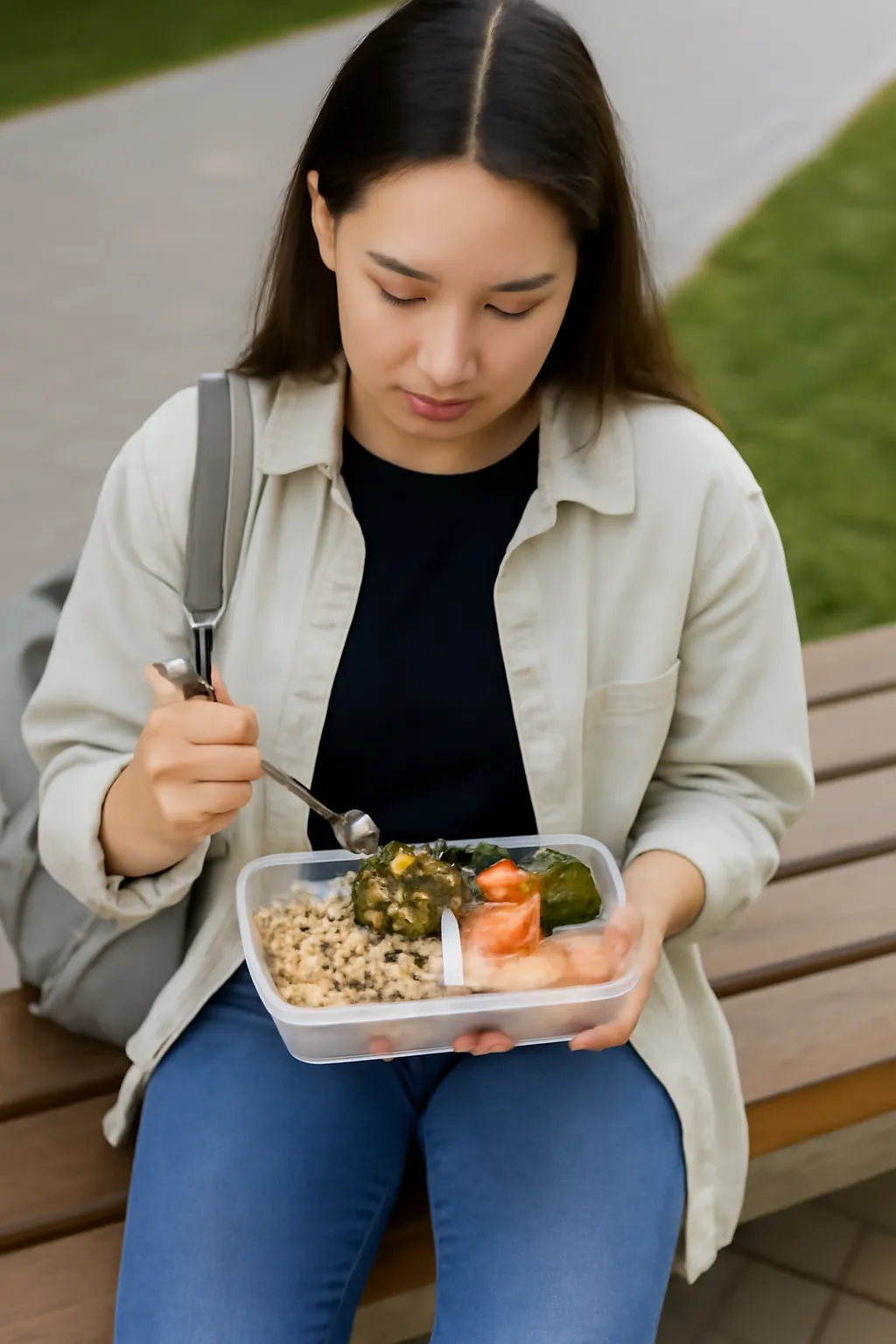Are you a college student struggling to eat healthy on a busy schedule? Discover easy and nutritious lunch box ideas that are perfect for university students, with tips on creating a balanced diet while managing time and budget.
College life is often hectic, balancing studies, extracurricular activities, and social engagements. One of the biggest challenges students face is maintaining a healthy diet on a tight budget and busy schedule. A university student lunch box can be a game-changer, offering a simple, practical solution for managing nutrition while staying within your budget. Let’s dive into the world of lunch boxes and explore how they can be tailored to meet the needs of a college student’s lifestyle.
College Student Lunch Box: Why It’s Important
As a college student, it’s easy to fall into the trap of unhealthy eating habits—grab-and-go snacks, fast food, and late-night cravings can take over. However, preparing your lunch box ahead of time can prevent these pitfalls, ensuring that you get the nutrition you need for sustained energy and focus throughout the day.
Benefits of a College Student Lunch Box
-
Cost-effective: Instead of splurging on take-out meals, packing your lunch can save you money over time. Preparing meals in bulk also allows you to buy ingredients in larger quantities, reducing the overall cost per meal.
-
Healthier options: When you pack your own lunch, you have full control over the ingredients. This means you can opt for fresh produce, lean proteins, and whole grains, avoiding the excessive sugars and unhealthy fats often found in fast food.
-
Time-saving: A well-planned lunch box can save you time during your busy day. Whether you’re eating between classes or studying, having a ready-to-go meal ensures you don’t have to waste time figuring out what to eat.
-
Customizable: Every college student has unique dietary needs, whether you’re vegetarian, vegan, gluten-free, or following a specific nutrition plan. Preparing your lunch allows you to customize your meals to suit your preferences.
Practical Tips for Packing Your Lunch Box
-
Plan ahead: Set aside time each week to plan your meals. Having a schedule helps you prepare your ingredients and cook in bulk to avoid daily meal prep stress.
-
Include a variety of food groups: A balanced meal includes protein, carbs, healthy fats, and fiber. For example, a lunch box could contain chicken, quinoa, mixed vegetables, and a side of fruit.
-
Use airtight containers: Keep your meals fresh by investing in good-quality lunch boxes with airtight seals. This prevents leaks and helps your food stay fresh until it’s time to eat.
By planning and preparing your meals ahead of time, you can enjoy a variety of healthy, filling options that fuel you for the day ahead.
University Student Lunch Box: Ideal Meal Components
A university student lunch box should focus on convenience, nutrition, and taste. When considering what to pack, aim for meals that are easy to prepare and can hold up well throughout the day. The ideal lunch box should include a mix of proteins, complex carbohydrates, vegetables, and healthy fats.
Key Components of a Healthy University Student Lunch Box
-
Protein-rich foods: Protein is essential for muscle repair and energy, especially for students who engage in physical activities or long study sessions. Options include chicken breast, tofu, boiled eggs, or lentils.
-
Whole grains: Complex carbohydrates, such as brown rice, quinoa, or whole wheat bread, provide long-lasting energy. Whole grains are also rich in fiber, which aids digestion and keeps you feeling fuller for longer.
-
Vegetables and fruits: Load your lunch box with colorful vegetables like spinach, broccoli, or carrots. These nutrient-dense foods are packed with vitamins and minerals that promote overall health. Pair them with some fresh fruit like apples, berries, or oranges for an added boost of antioxidants.
-
Healthy fats: Avocados, nuts, and seeds are excellent sources of healthy fats that contribute to brain function and heart health. A small handful of almonds or a drizzle of olive oil over your salad can make a big difference.
-
Dressing and seasoning: Don’t forget to pack a small container of dressing or seasonings. A simple vinaigrette or soy sauce can enhance the flavor of your meal without adding too many extra calories.
Sample Lunch Box Ideas for University Students
-
Grilled Chicken and Quinoa Salad: Combine grilled chicken, quinoa, spinach, tomatoes, and cucumbers, topped with a lemon vinaigrette. This meal is high in protein and fiber, keeping you satisfied throughout the day.
-
Sweet Potato and Black Bean Burrito Bowls: For a vegetarian option, pack sweet potatoes, black beans, avocado, and corn. Add some salsa and a side of brown rice for a hearty, filling meal.
-
Turkey and Veggie Wrap: Fill a whole-wheat tortilla with lean turkey slices, mixed greens, carrots, and a light spread of hummus. This is a portable, easy-to-eat option that’s perfect for busy days.
By focusing on balanced meals with a variety of nutrients, you can ensure your lunch box becomes an essential part of your daily routine.
Making a College Student Lunch Box: Tips and Tricks
Preparing a college student lunch box doesn’t have to be a daunting task. With a little bit of planning and creativity, you can enjoy healthy and delicious meals every day. Here are a few tips to make the process even easier.
Simple Meal Prep Strategies
-
Batch cook: On weekends, cook in bulk—grains like rice or quinoa, roasted vegetables, and proteins like chicken or tofu. Store them in individual portions so you can easily grab and pack them throughout the week.
-
Use leftovers creatively: Leftovers from dinner can make a great lunch the next day. For example, roasted chicken from dinner can be added to a salad or wrapped in a whole-wheat tortilla for a quick lunch.
-
Portable snacks: Alongside your main meal, pack a few healthy snacks like yogurt, fruit, or nuts. These will keep your energy levels up in between classes or study sessions.
-
Invest in good lunch boxes: Choose containers that are microwave-safe, leak-proof, and come with compartments to separate your food. This will keep your lunch organized and prevent sogginess.
-
Pre-portion ingredients: Instead of preparing your entire meal at once, you can pre-portion ingredients. For example, keep your salad dressing in a small container, and pack your veggies and grains separately to maintain freshness.
Quick and Easy Recipes for Busy Students
-
Overnight Oats: A quick breakfast option, overnight oats require minimal prep time. Just mix rolled oats with your favorite milk or yogurt, and add toppings like nuts, fruits, or chia seeds. Let it sit in the fridge overnight, and it’s ready to go in the morning.
-
Mason Jar Salads: Layer your salad ingredients in a mason jar, starting with the dressing at the bottom, followed by proteins and vegetables, and ending with leafy greens at the top. When you’re ready to eat, just shake it up.
-
Egg Muffins: Whisk eggs, spinach, cheese, and your favorite veggies, pour the mixture into a muffin tin, and bake. These egg muffins can be stored in the fridge and are easy to grab for breakfast or lunch.
By adopting these meal prep strategies, you’ll save time and stress, ensuring that you always have a nutritious meal ready to eat.
In conclusion, the key to maintaining a healthy and balanced diet as a college student lies in meal planning and preparing. A university student lunch box can be a cost-effective, time-saving, and nutritious way to stay on top of your health. With the right ingredients and a bit of creativity, you can make sure that each meal is both satisfying and beneficial to your overall well-being.
“Failing to prepare is preparing to fail,” and with a bit of effort, your lunch box will become your best friend in maintaining a healthy college lifestyle.






